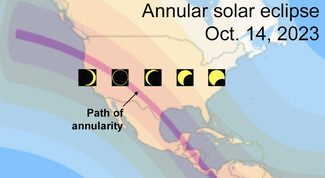Ring of Fire Eclipse!
Last updated 11/9/2023 at 2:09pm
When did you last see an eclipse of the sun? Seems like ages, doesn't it?
The last one visible from North America occurred six years ago – on Aug. 21, 2017. If you missed it, you'll have another chance on Saturday, Oct. 14, and you'll not want to miss this one.
A Solar eclipse occurs when the moon in its orbit around the Earth slips between our planet and the sun and blocks a portion of our star from view. And, as you might expect, it occurs during the daytime!
On that day, viewers throughout much of North America will watch as the moon's silhouette appears to take an increasingly larger bite out of the sun's disk. How it appears, however, depends on where you're located – and the weather, of course!
Most of us will see a partial eclipse. In this type of eclipse, the moon blocks only part of the sun's disk from view. At maximum eclipse, we can expect to see the sun as a thin or thick crescent. Those along the Atlantic coastline will see the smallest bite taken out of the sun's disk, but those who view from farther to the west and southwest will see a greater eclipse. And sky watchers who live along a narrow swath stretching from Oregon to Texas – or who are willing to travel to this path – will enjoy an even rarer sight: an annular eclipse.
This occurs only when the moon appears slightly smaller than normal and the sun appears slightly larger than normal, and the moon occults only the central portion of the sun's disk, producing a weird ring of sunlight: an "annulus." The closer to the center of this path you are, known as the "centerline," the more symmetrical this "ring of fire" will appear.
To learn how the eclipse will appear from your location, visit timeanddate.com, then hover your cursor over "Sun, Moon & Space" at the top. A drop-down menu will appear, and you can click on "October 14 Annular Solar Eclipse." Then just enter your location, and you'll see the exact times of the show and a simulated view of how it'll appear in your sky.
Viewing the eclipse directly is not difficult but requires strict attention to protecting your eyes. Improper viewing techniques can cause serious eye damage or permanent blindness. Looking at the sun without a proper Solar filter – even for an instant – can cause permanent eye damage or blindness.
You must never view the sun with the naked eye, sunglasses, double thickness of darkened film, smoked glass or other homemade filters. Only certified Solar filters reduce visible and invisible radiation enough to be safe; these are necessary during both the partial and annular phases of this eclipse.
To learn more about proper Solar viewing filters, visit the American Astronomical Society (eclipse.aas.org) and click on "Eye Safety"; or to find safe Solar filters and viewers, click on "Resources." Be sure to order these soon, however, since they will sell out quickly as eclipse day approaches.
Next week, I'll offer some additional tips on safe viewing and even how to photograph the sky show, so stay tuned!




